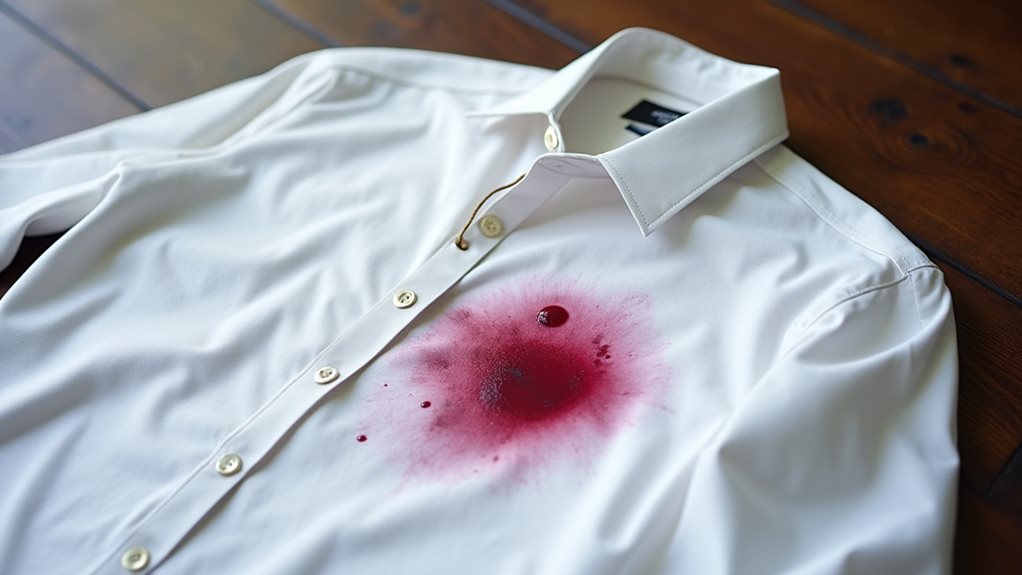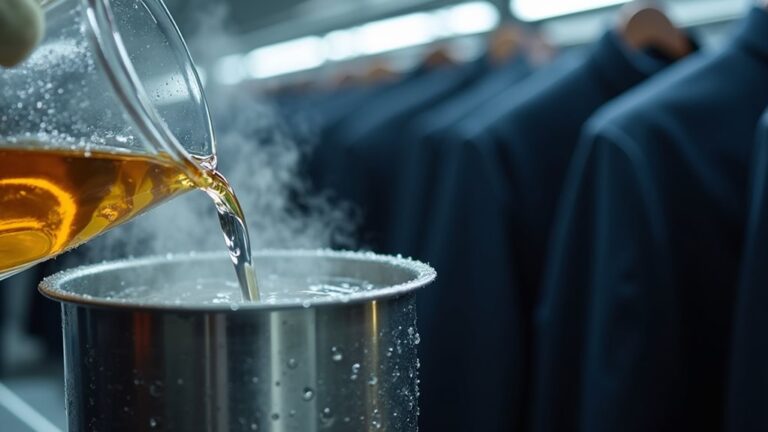No, dry cleaning doesn’t set stains—it’s actually your home dryer’s heat and agitation that creates those permanent, heartbreaking marks on your favorite clothes. Professional dry cleaning uses specialized solvents that dissolve stains at the molecular level without water or harsh heat, making it particularly effective for oil-based stains that would otherwise bond permanently with fabric fibers. The key is acting quickly and communicating stain details to your cleaner for best results.
Understanding How Dry Cleaning Actually Works on Stains
When you’re standing there staring at that fresh wine stain on your favorite silk blouse, wondering if dry cleaning will magically erase your dinner party mishap or somehow make it worse, it helps to understand what’s actually happening behind those mysterious curtains at the cleaners.
Unlike your home washing machine that relies on water and detergent, professional dry cleaners use specialized solvent-based cleaning agents that work like molecular ninjas, dissolving tough stains at their core rather than just pushing them around the fabric fibers.
The beauty of dry cleaning lies in how these cleaning agents penetrate deep without the harsh agitation that can set stains permanently.
However, quick action remains your best friend – old stains become stubborn enemies that even professional stain removal techniques struggle to conquer completely.
Professional dry cleaners typically use perchloroethylene or other specialized solvents that excel at dissolving grease and oil-based stains without damaging delicate fabric fibers.
Common Misconceptions About Dry Cleaning and Stain Setting
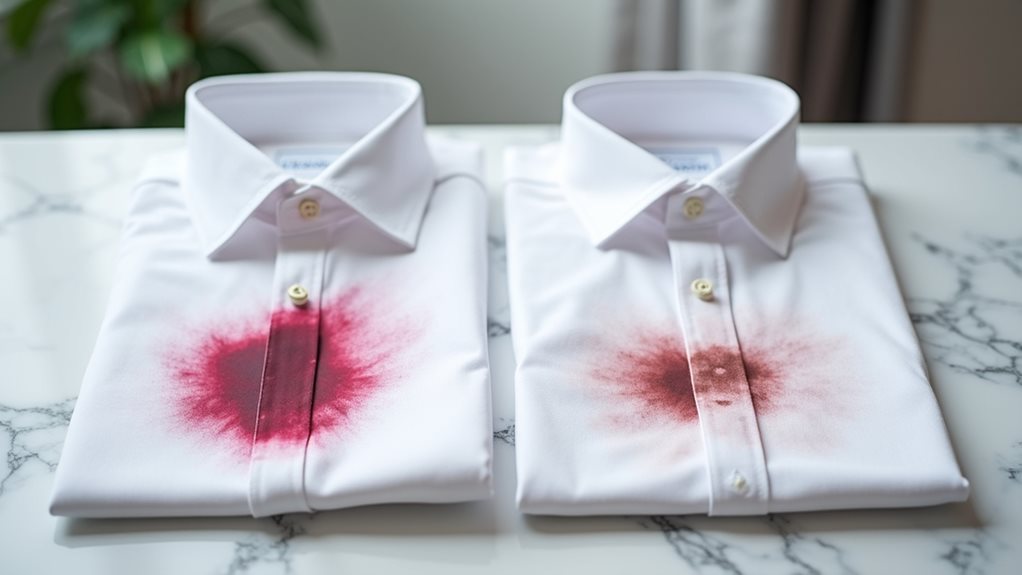
Despite what your well-meaning aunt might’ve told you after that unfortunate red wine incident at last year’s holiday dinner, dry cleaning doesn’t actually set stains into your clothes like some kind of permanent fabric curse.
These misconceptions about professional dry cleaning often stem from unrealistic expectations – you can’t expect every stubborn stain to vanish completely, especially those sneaky protein-based stains or vibrant dye stains that’ve been camping out on your favorite shirt for months.
Even the most skilled dry cleaner can’t work miracles on that ancient coffee stain you’ve been ignoring for six months.
The real culprit behind set-in stains isn’t the dry cleaning process itself, but rather the heat and agitation that happens when you toss stained items into your home dryer without proper treatment first.
Professional dry cleaning actually preserves fabric integrity while providing effective stain removal when you communicate openly about specific stains.
The dry cleaning process uses chemical solvents instead of water, making it particularly effective at removing oil-based stains, grease, and makeup that regular washing simply can’t handle.
Factors That Determine Successful Stain Removal
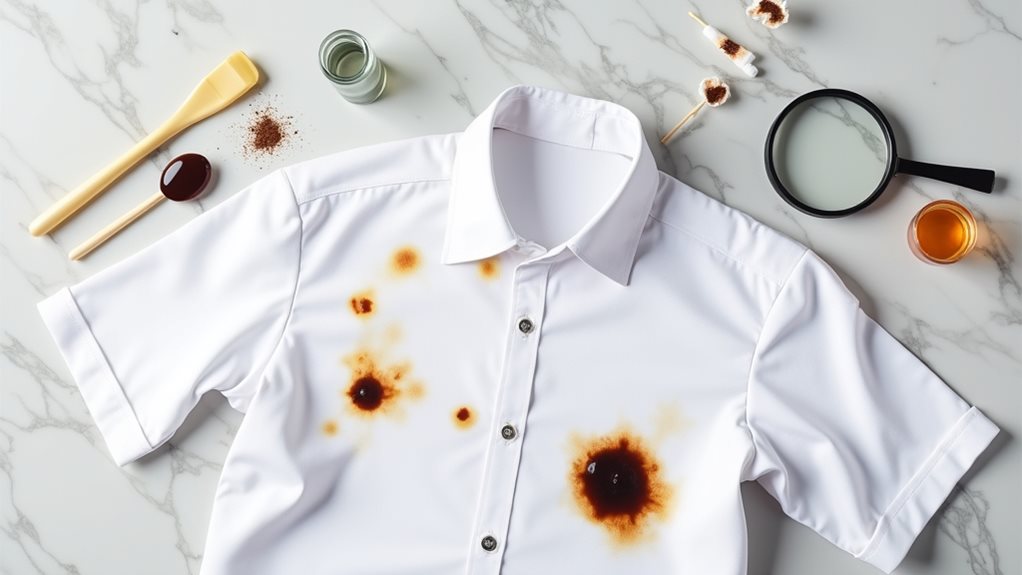
When you’re wondering whether your favorite shirt can be saved, the success of stain removal really comes down to two vital factors that I’ve learned matter more than anything else through years of dry cleaning mishaps.
The age and type of your stain work together like a ticking clock – that fresh wine spill from last night’s dinner party has a fighting chance, but the mystery grease spot you’ve been ignoring for months becomes your dry cleaner’s nemesis.
Your fabric’s material also plays a starring role in this drama, since delicate silk responds completely differently to treatment than your trusty cotton work shirt, and understanding this relationship can mean the difference between rescue and resignation.
The chemical composition of dry cleaning solvents like perchloroethylene makes them particularly powerful against oil-based stains and certain dyes, though some permanent colorants may still prove impossible to eliminate completely.
Stain Age and Type
As someone who’s learned this lesson the hard way after ruining a favorite silk blouse, I can tell you that timing and stain type aren’t just important factors in dry cleaning success—they’re absolutely everything.
When you spill red wine on your shirt, the clock starts ticking immediately, because stain age determines how deeply those molecules bond with your fabric’s fibers.
Protein stains like sweat require enzyme treatments, while oil-based stains need completely different solvents—and professional cleaners know this distinction can make or break your garment’s future.
Set-in stains become increasingly stubborn, especially on delicate fabrics that limit aggressive treatment options.
Quick action isn’t just helpful advice; it’s your best defense against permanent damage that even the most skilled dry cleaner can’t reverse.
While dry cleaning excels at removing grease, makeup, and food stains using specialized solvents, it has limitations with water-based stains like blood or certain beverages.
Fabric Material Considerations
The fabric beneath that stubborn stain holds just as much power over your cleaning outcome as the stain itself, something I discovered when my favorite cashmere sweater emerged from dry cleaning with a mysterious shiny patch where chocolate once lived.
Fabric material considerations truly matter – delicate fabrics like silk demand gentler approaches that might limit aggressive stain removal techniques.
While synthetic fibers often cooperate beautifully with solvents, allowing chemicals to work their magic without absorbing deeply, natural fibers can be stubborn allies in the cleaning process.
Your embellishments and special treatments add another layer of complexity, requiring damage prevention strategies that sometimes mean accepting partial results.
The chemical solvents used in dry cleaning work differently on various fabric types, with natural fibers like wool, cotton, and silk responding uniquely compared to synthetic materials during the stain removal process.
Types of Stains That Respond Best to Dry Cleaning
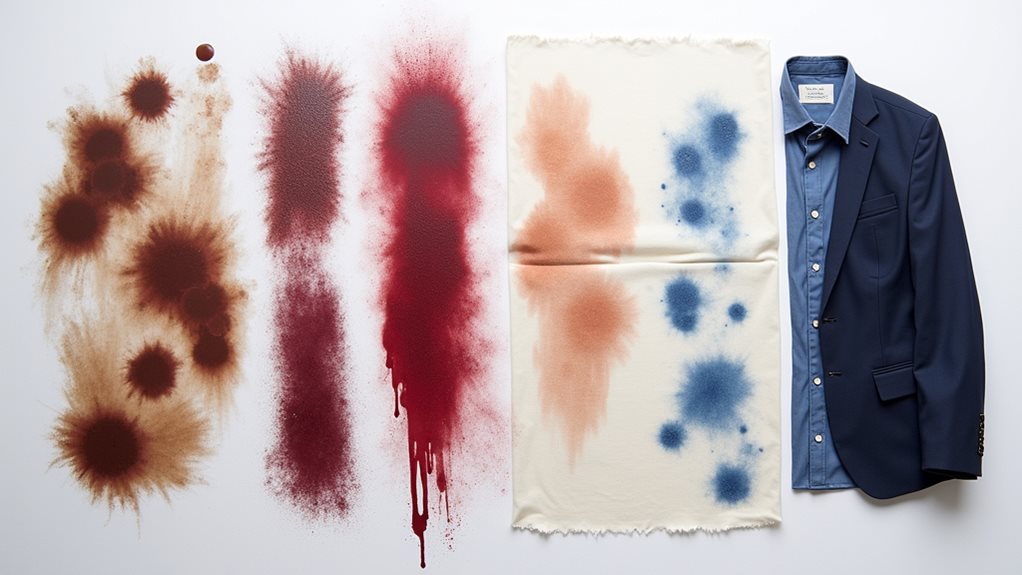
When you’re standing there staring at that greasy salad dressing splatter on your favorite silk blouse, you’ll be relieved to know that oil-based stains are actually dry cleaning’s specialty, since those pesky petroleum-based substances just laugh in the face of your home washing machine’s water-based approach.
Your morning coffee mishap or that unfortunate red wine incident from last weekend’s dinner party might seem like fabric death sentences, but protein and tannin stains actually respond beautifully to the specialized enzyme treatments that professional dry cleaners use—I learned this the hard way after ruining a white shirt trying to tackle a blood stain with cold water and prayer 😅.
The truth is, these stubborn stains need the targeted chemical arsenal that dry cleaning provides, rather than the generic soap-and-water routine that works great for everyday dirt but falls short when you’re dealing with life’s messier moments.
Unlike water-based washing that can cause shrinkage and color bleeding, dry cleaning uses chemical solvents to safely remove these challenging stains without damaging the fabric’s structure or appearance.
Oil-Based Stain Removal
Among all the stubborn stains I’ve battled over the years, oil-based culprits like cooking grease, makeup foundation, and motor oil have taught me the most humbling lessons about when to wave the white flag and head straight to the dry cleaner.
Here’s why professional dry cleaners dominate when removing oil from your precious garments:
- Their specialized cleaning solvents penetrate deep into fabric fibers, dissolving tough stains at the molecular level.
- They protect delicate fabrics while delivering effective stain removal that home stain removal products simply can’t match.
- Time works against you—prompt professional treatment prevents oil stains from bonding permanently with fibers.
- Their chemical agents target lipid-based residues without damaging your garment care investments.
- Home remedies often backfire, setting stains deeper 😬
Professional dry cleaners typically use chemical solvents like perchloroethylene or petroleum-based alternatives that are specifically formulated to dissolve oil and grease that regular water-based washing cannot eliminate.
Trust me, proper garment care means knowing your limits!
Protein and Tannin Stains
Although I’ve watched countless clients panic over red wine spills and coffee catastrophes, protein stains and tannin stains actually represent some of the most treatable challenges when you act fast and choose professional dry cleaning.
Here’s what I’ve learned: protein stains from blood, sweat, and dairy bond aggressively with fabric fibers, while tannin stains from coffee and wine require immediate attention before they permanently set.
Traditional washing often fails because it lacks the specialized enzyme solutions that dry cleaning employs to effectively remove these stubborn marks.
Professional cleaners can preserve fabric integrity while targeting specific stain compositions, something your home washing machine simply can’t match.
The key to successful stain removal? Don’t wait—professional intervention makes all the difference.
Dry cleaning’s effectiveness with these stains comes from using chemical solvents instead of water, which can dissolve protein and tannin compounds that water-based cleaning methods struggle to remove.
When Stains Become Permanently Set and Why
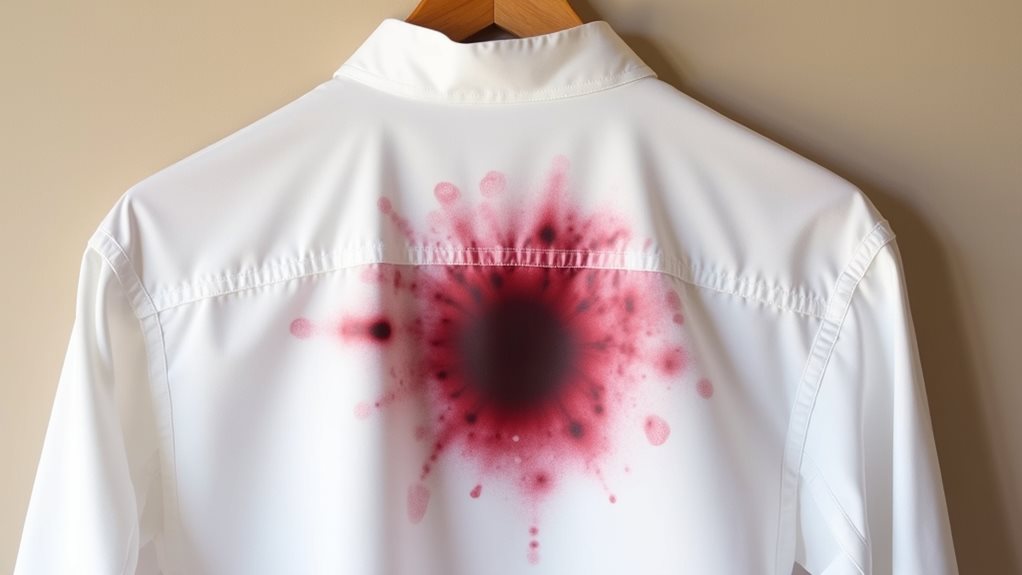
Time becomes your worst enemy once a stain lands on your favorite shirt, because every minute that passes allows those unwanted molecules to burrow deeper into the fabric fibers like tiny invaders setting up permanent camp.
Heat from your dryer acts like cement, bonding those stubborn marks permanently to your clothing’s fabric.
Here’s what makes set-in stains so heartbreakingly difficult to remove:
- Oil stains laugh at your desperate attempts once they’ve settled in
- Professional dry cleaning can’t always save deeply penetrated marks
- Your procrastination literally costs you your favorite garments 💔
- Heat treatment turns temporary problems into permanent disasters
- Time transforms simple spills into impossible cleaning challenges
When you finally seek professional treatment, even experienced cleaners struggle with old stains that have already bonded completely with fabric fibers, making removal nearly impossible.
While dry cleaning uses chemical solvents like perchloroethylene to dissolve stains that water cannot penetrate, even these powerful cleaning methods have their limitations when dealing with stains that have become permanently set over time.
Proper Stain Treatment Before Taking Items to Dry Cleaners
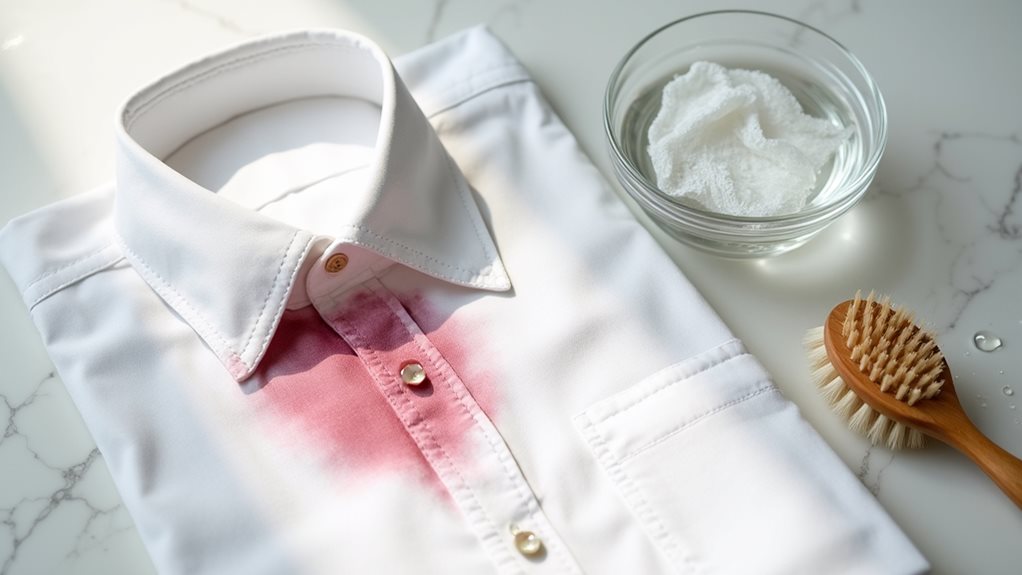
The good news is that you can dramatically improve your chances of stain removal success by taking the right steps before you even walk through your dry cleaner’s door, and I learned this lesson the hard way after ruining my favorite silk blouse with a well-intentioned but misguided cleaning attempt.
When dealing with delicate fabrics, prompt treatment matters most—gently blot with a clean cloth instead of rubbing, which prevents stains set further into fibers.
Resist trying home remedies that risk damaging the garment, as removing tough stains requires professional expertise.
Instead, communicate details about the stain’s type and timing to your cleaner, avoiding storage that makes professional stain removal more challenging.
Professional dry cleaners use specialized solvents and pre-treatment techniques specifically designed to break down protein-based stains like blood, which can be challenging to remove with regular water-based cleaning methods.
Professional Techniques That Prevent Stain Setting During Cleaning
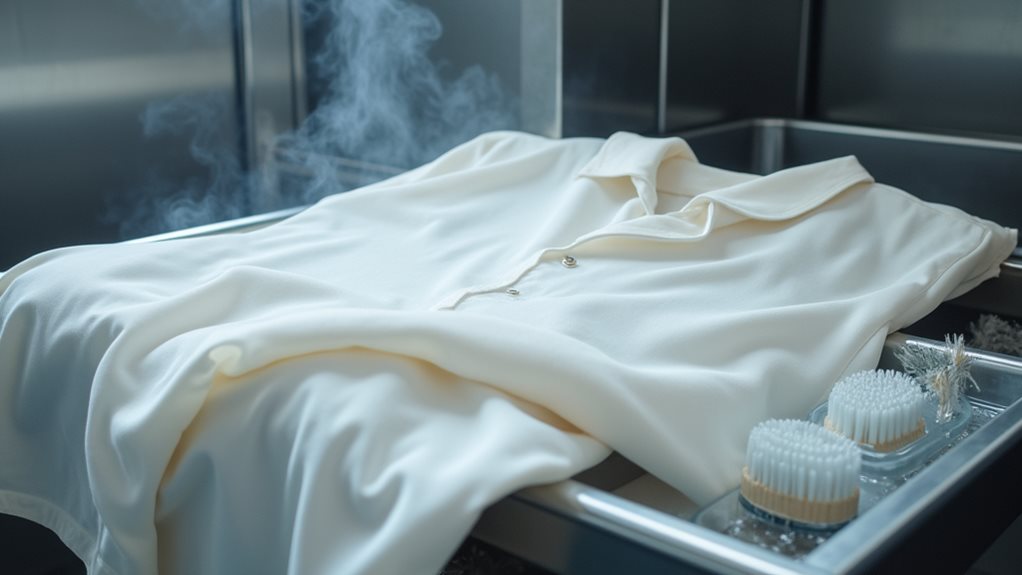
Three key professional techniques make all the difference between stain removal success and permanent fabric damage, and I wish I’d understood this years ago when I handed over my wine-stained dress without explaining what happened.
Professional dry cleaners use specialized approaches that protect your delicate fabrics while tackling tough stains effectively.
Here’s what separates expert cleaners from amateur attempts:
- Targeted dry cleaning solvents dissolve stains without water, preventing the setting that happens during traditional washing.
- Immediate stain assessment helps cleaners identify the best treatment before fibers bond permanently with the substance.
- Enzyme-based solutions break down protein stains while preserving fabric integrity throughout the cleaning process.
- Multi-step treatments guarantee stains are lifted completely, addressing every component that could cause permanent damage.
- Professional expertise means cleaners can remove even stubborn stains without damaging your precious garments.

